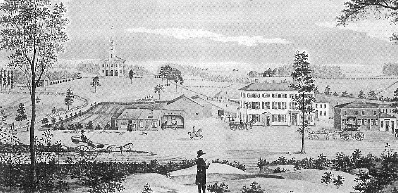In 1734, the Town bought 4 acres of land from William Pike, son of Jeremiah, for a new town center that would include a new much needed Meetinghouse. In 1735, the Second Meetinghouse was built at the North-East corner of what is now the Framingham Centre Common.
It was a big building, 42 feet wide and 54 feet long, with 3 stories and a double gallery inside. There was no tower, no steeple, and no bell. They would not paint it for 40 years, but it would serve the town well for more than 70 years.
Excerpt taken from Framingham, an American town by Stephen Herring.
The building of the Second Meetinghouse was followed (over the years) by the laying out of roads that would connect Framingham Centre to the other Framingham districts. This "new" network included Edgell Road, Central Street, Pleasant Street, Main Street (from Buckminster Square) and Salem End Road (East end).

Framingham Centre today, hub of a network of "old" roads. Thanks to googlemaps.
Changes to the Framingham Centre area would occur around the time the Worcester Turnpike (the stage coach toll road connecting Worcester to Boston) opened in 1810. Businesses opened on both sides of the new road. The area between the Second Meetinghouse and the shops was cleared of its pines and oaks to become the Centre Common.
As early as 1805, there were talks of a third Meetinghouse to replace the plain looking out of style Second Meetinghouse. In 1808, Framingham had a brand new (third) Meetinghouse, centered at the North end of the Centre Common (West of the old one). It had a three-stage tower, a spire, and a bell (of Paul Revere origin perhaps). A new Town House was built in 1809 where the Second Meetinghouse stood, using its posts, planks and beams. This paved the way to the separation of Church and Town in Framingham.

The Worcester Turnpike (now Route 9) is at the foreground with Abner Wheeler's Hotel predominantly represented. The Third Meetinghouse is at the top of the Common. Thanks to Captain Daniel Bell, 1808.
The next meetinghouse would actually be referred to as a Town Hall. It would be built in 1834 at the South end of the Centre Common. This Greek revival building is still standing today and is known as "Village Hall".
In 1846, the Third Meetinghouse, home of the First Parish congregation, was torn down to make way for a smaller and more modern church (destroyed by fire in 1920). Today, the site is occupied by the First Parish Unitarian church.
No comments:
Post a Comment